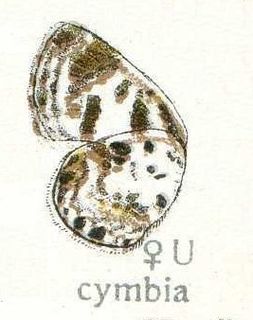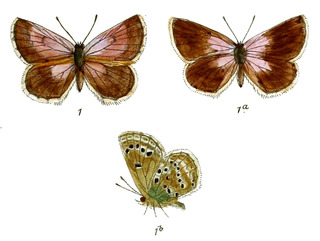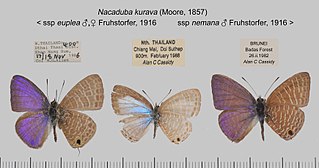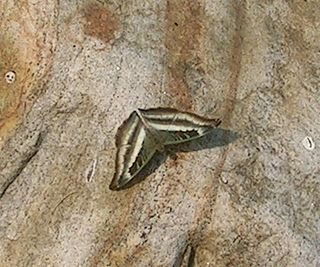Description
Male
Upperside: dark purple, sometimes fuliginous, sometimes bright and shining. Forewings and hindwings: terminal margins edged with fuscous brownish black and an anteciliary jet-black line; cilia brown; tail black tipped with white. Underside: more or less dingy white. Forewing: a broad oblique brownish-black band from base to just before the middle of the costa; from the latter a dark brownish-black bar proceeds vertically down to middle of interspace 3, on the inner side of this and touching it in the middle is a large brownish-black irregular spot that extends posteriorly to vein 1; beyond this a broad discal transverse brownish-black band twice interrupted, the posterior portion slightly narrowed below is shifted obliquely inwards and ends on vein 1; this is followed by a postdiscal transverse series of brownish-black spots that anteriorly nearly coalesces with the discal band, a transverse subterminal line of similar but smaller spots and a well-marked anteciliary black line. Hindwing: a basal short, brownish-black, anteriorly attenuate bar placed obliquely, a transverse subbasal band of four large coalescent black spots, a transverse curved discal band twice broken as on the forewing and similar postdiscal subterminal and terminal markings. Antennae black, shafts ringed with white, head, thorax and abdomen dark brownish black; beneath: the palpi black, thorax and abdomen down the middle white. [3] [5]
Female
Upperside: fuscous black. Forewings and hindwings: in most specimens the markings of the underside show (sometimes very conspicuously) through. Underside: as in the male. Antenna, head, thorax and abdomen similar to those of the male. [3]
Larva
"Like that of Castalius ananda feeds only on the parenchyma of the leaf .... It is of the usual woodlouse form, slightly flattened head concealed in the second segment; surface more or less rough; a fringe of long white bristles all round with an erected ridge of similar bristles along the back from the second segment; those on the 3rd and 7th segments and the last two much longer than the others; those on the 2nd segment very few, short and black. It has a conspicuous gland on the 12th segment, and is attended by small species of ants of the genus Crematogaster . Its colour is pale green, the dorsal portion of the 2nd, 4th, 5th, 6th and last two segments being dark brown, while the centre segments are almost yellow with a darker dorsal line. We found it feeding on Zizyphus xylopyrus and also on Loranthus , where it was attended by Crematogaster ants." [3]
Pupa
"Of the usual Castalius form but narrow and slightly flattened. It is intensely glossy as if covered with gum. It varies in colour, being sometimes black, at others green with inconstant black markings." (Davidson, Bell & Aitken) [3]

Luthrodes pandava, the plains Cupid or cycad blue, is a species of lycaenid butterfly found in India, Sri Lanka, Myanmar, United Arab Emirates, Indochina, Peninsular Malaysia, Singapore, Taiwan, Java, Sumatra and the Philippines. They are among the few butterflies that breed on plants of the cycad class.

Discolampa ethion, the banded blue Pierrot, is a contrastingly marked butterfly found in South Asia that belongs to the blues or family Lycaenidae. The species was first described by John O. Westwood in 1851.

Delias pasithoe, the redbase Jezebel is a medium-sized butterfly of the family Pieridae, that is, the yellows and whites. The species is found in parts of South Asia and Southeast Asia. There has been some dispute for which species the specific name aglaja, used twice by Linnaeus in 1758, applies – the redbase Jezebel, or the dark green fritillary, a brush-footed butterfly. Here, Delias pasithoe is used for the redbase Jezebel, based on the replacement name proposed by Linnaeus himself.

Castalius rosimon, the common Pierrot, is a small butterfly found in India that belongs to the lycaenids, or blues family.

Tarucus theophrastus, the common tiger blue, pointed Pierrot or African Pierrot, is a small butterfly found in the Old World tropics. It belongs to the lycaenids or blues family.

Azanus ubaldus, the bright babul blue, desert babul blue, or velvet-spotted blue, is a small butterfly found in India, the Middle East and Africa that belongs to the lycaenids or blues family.

Azanus jesous, the African babul blue or topaz-spotted blue, is a small butterfly found in Africa, Egypt, Syria, India, Sri Lanka and Myanmar that belongs to the lycaenids or blues family.

Niphanda cymbia, the pointed Pierrot, is a small butterfly found in northern India, Burma and northern Borneo that belongs to the lycaenids or blues family.

Chilades lajus, the lime blue, is a small butterfly found in India, Sri Lanka, Myanmar, Taiwan, Hong Kong, Hainan, Mangulam Island, Sulawesi and the Philippines that belongs to the lycaenids or blues family.

Jamides celeno, the common cerulean, is a small butterfly found in Indomalayan realm belonging to the lycaenids or blues family. The species was first described by Pieter Cramer in 1775.

Lycaenopsis marginata, the margined hedge blue, is a small butterfly found in India that belongs to the lycaenids or blues family.

Alpherakya devanica is a species of Lycaenid butterfly found in Asia.

Nacaduba kurava, the transparent six-line blue, is a Lycaenidae butterfly found in Asia and Australia. The species was first described by Frederic Moore in 1857.

Nacaduba hermus, the pale four-line blue, is a species of lycaenid butterfly found in Indomalayan realm. The species was first described by Baron Cajetan von Felder in 1860.

Athyma nefte, the colour sergeant, is a species of brush-footed butterfly found in tropical South and Southeast Asia.

Athyma zeroca, the small staff sergeant, is a species of nymphalid butterfly found in tropical and subtropical Asia.

The Indian fritillary is a species of butterfly of the nymphalid or brush-footed family. It is usually found from south and southeast Asia to Australia.

Apporasa is a genus of butterflies in the family Lycaenidae, the blues. The genus is monotypic containing only Apporasa atkinsoni, the crenulate oakblue. It is found in the Indomalayan realm.

Catochrysops strabo, the forget-me-not, is a small butterfly found in Asia that belongs to the lycaenids or blues family. The species was first described by Johan Christian Fabricius in 1793. It is found in Sri Lanka, India, from Sikkim to Indochina and in Sundaland, Sulawesi and the Philippines.

Auzakia is a monotypic butterfly genus in the family Nymphalidae. It contains the single species, Auzakia danava, the commodore, which is found from Tibet to Sumatra.























